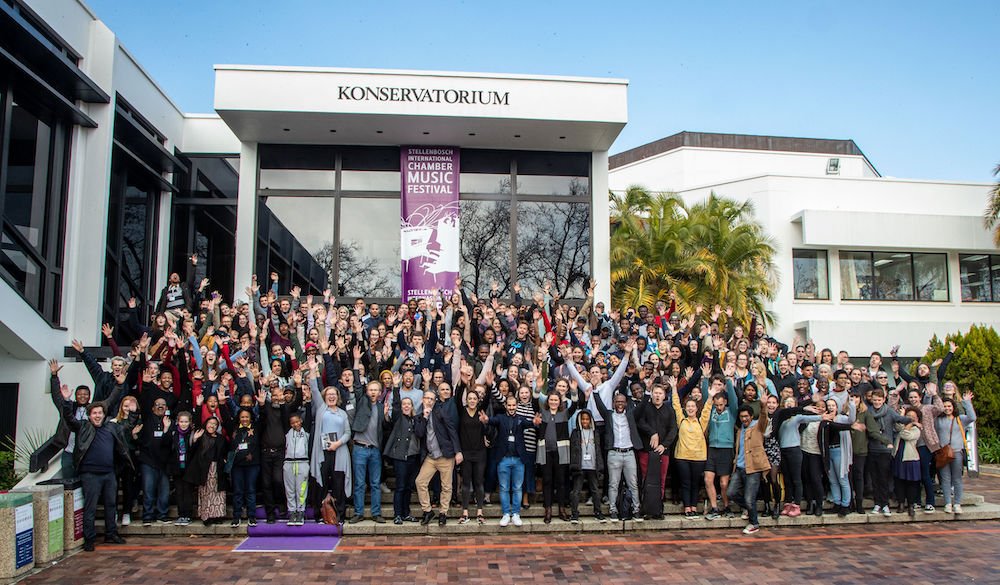
About his magnificent Organ Symphony, Saint-Saëns wrote: “With it, I have given all that I could give. What I did, I could not achieve again.” After sixteen years, the team at the Stellenbosch International Chamber Music Festival continues to achieve remarkable success, again and again.
Earlier on Sunday, the Festival Concert Orchestra performed a special community concert in nearby Jamestown. Now, in the Endler Hall, the Festival Symphony Orchestra was about to open the final performance. Conductor Xandi van Dijk arrived on stage with a mischievous smile on his face and bounced onto the podium after greeting the audience. What did he have up his sleeve?
“One, two. One, two, three…” After counting aloud, rock band-style, the orchestra launched into their second rendition of Matthijs van Dijk’s Dance. Any of the hesitations from Friday’s night performance had been dispelled as this nightclub-inspired reverie, transcending the traditional compartmentalisation of musical styles, had the audience bopping in their seats. Afterwards, the composer came to the stage and the two brothers embraced.
Jean Sibelius (1865-1957) composed Andante Festivo to celebrate the anniversary of a sawmill. It was originally writtenfor string quartet, but Sibelius later rescored the piece for the sonorous sounds of string orchestra and timpani. The Finnish composer’s solemn, sweeping gestures – a blend of majesty and poignance – were reminiscent of the Adagio for Strings by Samuel Barber. The long phrases of this valedictory piece were imbued with intrinsic momentum and a clear sense of line.
Solo brass instruments have been somewhat elusive at this year’s SICMF (with the notable exception of Tyrannosaurus Sue), but trumpeter Marco Silva’s moment had now arrived. At the time it was composed, the Concerto for Trumpet and Orchestra by Henri Tomasi (1901-1971) was thought to be unplayable. About his composition, Tomasi wrote: “If the style of my Concerto for Trumpetis classic by its three movements, the content is not. There is neither subject nor central theme. It is pure music. I tried to make a synthesis of all the expressive and technical possibilities of the trumpet, from Bach up to the present, including jazz.”
Unlike Haydn’s Trumpet Concerto, which is more frequently heard in the concert hall, Tomasi’s concerto demonstrated the full expressive range of the instrument. The full-horn opening fanfare was immediately contrasted with a distant, muted passage. In the second movement, the trumpet was accompanied by sweeping harp arpeggios. This was answered by a passage of lush string-writing before returning to the trumpet and harp duet, while the street music-inspired finale brought all the other instruments alive. Not satisfied with having conquered this “unplayable” concerto, Silva stunned the audience with a party piece of immense virtuosity.
After the interval, the spine-tingling opening chords of Saint-Saëns’s Symphony No. 3materialised seamlessly out of the silence. The intense focus of the orchestra was palpable, and the balance between sections was much improved compared to Friday. By conducting with his hands in the Poco adagio “movement”, Xandi brought a special intimacy to this gentle section which was complemented by the phrasing of the agitated scherzo. After the famous organ entry, the sweeping piano figurations, evoking the crystalline reflections of sunbeams, celebrated the transformation of the thematic material into the tonic major and consolidated the composer’s message of hope and resurrection. After this triumphant finale, the brief encore of Bizet’sFarandole from L’ArlésienneSuite No. 2seemed almost superfluous. (Nobody was complaining, of course!)
And so, as the applause subsided for the final time, the atmosphere of achievement was mingled with melancholy – “bittersweet”, as Artistic Director Nina Schumannobserved.While the chairs and scores were packed away, the Festival family savoured their final moments together before returning home. But the lessons, friendships and experiences from this year’s Festival will resonate long into the future. “We call it Festival magic; something special happens every single year.”
What about 2020? Will it be “more of the same”? Festival Director Peter Martens was emphatic: “Just ‘more of the same’ is, in itself, a challenge. We want to do more of the same, but we also hope to be able to continue to grow in terms of recognition and stature – and in terms of fundraising, so that we can be even bolder with programming and with the variety of artists. More of the same – definitely. Bigger and better – also.”
John Woodland